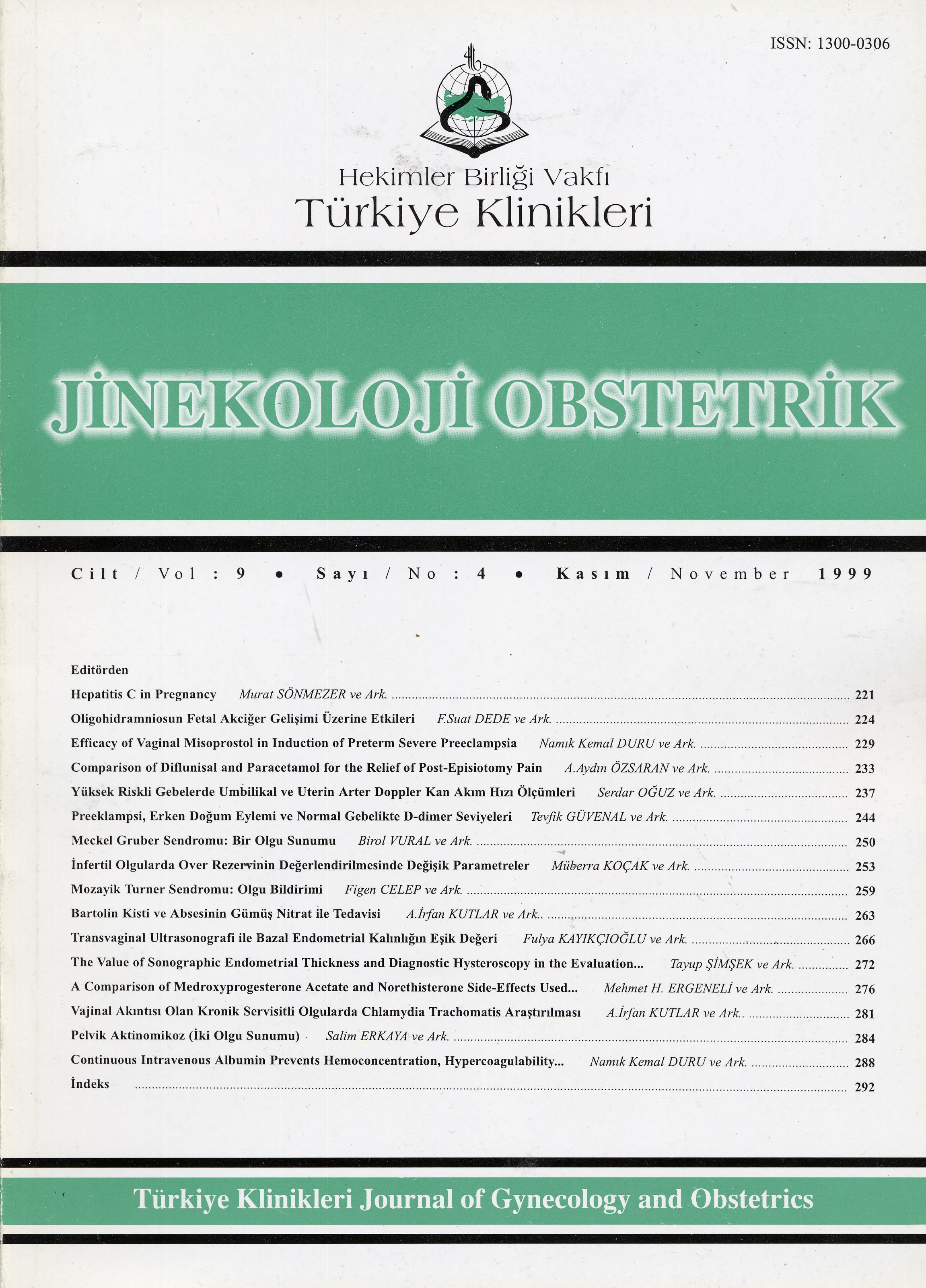Open Access
Peer Reviewed
ARTICLES
5300 Viewed2920 Downloaded
A Comparison of Medroxyprogesterone Acetate and Norethisterone Side-Effects Used inReproductive Age Women
Reprodüktif Çağ Kadinlarinda Kullanılan Medroksiprogesteron Asetat Ve Noretisteron Yan Etkilerinin Karşılaştırılması
Turkiye Klinikleri J Gynecol Obst. 1999;9(4):276-80
Article Language: TR
Copyright Ⓒ 2025 by Türkiye Klinikleri. This is an open access article under the CC BY-NC-ND license (http://creativecommons.org/licenses/by-nc-nd/4.0/)
ÖZET
Amaç: Anormal uterus kanaması olan reprodüktif çağdaki kadınlarda, kısa dönem kullanım için önerilen medroksiprogesteron asetat (MPA) ve noretisterona (NET) toleransın değerlendirilmesidir. Çalışmanın yapıldığı yer: Başkent Üniversitesi, Tıp Fakültesi, Kadın Hastalıkları ve Doğum Anabilim Dalı Materyal-Metod: Anormal uterus kanaması nedeniyle progestogen verilmesi planlanan 30 kadın rastgele şekilde iki gruba ayrılarak bir gruba MPA diğerine NET uygulandı. Hastalarda oluşan premenstrüel belirtile re benzer semptomlar Moos Menstrual Distress Questionaire ile değerlendirildi. Anketleri, MPA grubunda 12, NET grubunda 7 kadın tamamladı. Bulgular: Şiddetli progestogen yan etkileri MPA grubundaki kadınların %66.7sinde, NET grubundakilerin %14.3ünde saptandı. MPAın oluşturduğu semptomlar NETa göre daha şiddetli idi (p=0.039). Ağrı, konsantrasyon bozukluğu, davranış değişiklikleri, su tutulumu ve negatif etki belirtileri MPA grubunda belirgin olarak daha şiddetliydi (p<0.05). Sonuç: Reprodüktif çağdaki kadında progestogen yan etkilerinin en az olmasını ve dolayısı ile önerilen ilaca devamın sağlanabilmesi için ilk seçenek olarak NET tercih edilmelidir.
Amaç: Anormal uterus kanaması olan reprodüktif çağdaki kadınlarda, kısa dönem kullanım için önerilen medroksiprogesteron asetat (MPA) ve noretisterona (NET) toleransın değerlendirilmesidir. Çalışmanın yapıldığı yer: Başkent Üniversitesi, Tıp Fakültesi, Kadın Hastalıkları ve Doğum Anabilim Dalı Materyal-Metod: Anormal uterus kanaması nedeniyle progestogen verilmesi planlanan 30 kadın rastgele şekilde iki gruba ayrılarak bir gruba MPA diğerine NET uygulandı. Hastalarda oluşan premenstrüel belirtile re benzer semptomlar Moos Menstrual Distress Questionaire ile değerlendirildi. Anketleri, MPA grubunda 12, NET grubunda 7 kadın tamamladı. Bulgular: Şiddetli progestogen yan etkileri MPA grubundaki kadınların %66.7sinde, NET grubundakilerin %14.3ünde saptandı. MPAın oluşturduğu semptomlar NETa göre daha şiddetli idi (p=0.039). Ağrı, konsantrasyon bozukluğu, davranış değişiklikleri, su tutulumu ve negatif etki belirtileri MPA grubunda belirgin olarak daha şiddetliydi (p<0.05). Sonuç: Reprodüktif çağdaki kadında progestogen yan etkilerinin en az olmasını ve dolayısı ile önerilen ilaca devamın sağlanabilmesi için ilk seçenek olarak NET tercih edilmelidir.
ABSTRACT
Objective: To assess the tolerability to medroxyprogesterone acetate (MPA) and norethisterone (NET) prescribed as the first-choice progestogen for short-term use in reproductive-age women with abnormal uterine bleeding. Institution: Başkent University, School of Medicine, Department of Obstetrics and Gynecology Materials and Methods: Thirty reproductive-age women with abnormal uterine bleeding were randomly divided into two groups and MPA or NET was prescribed. Premenstrual-like symptoms were assessed using Moos Menstrual Distress Questionaire before and during the progestogen use. Twelve patients in the MPA group and seven patients in the NET group returned the questionaires. Results: Progestogen sufferers were 66.7% in the MPA group and 14.3% in the NET group. MPA caused significantly more severe premenstrual-like symptoms than NET (p=0.039). Symptoms of pain, lack of concentration, behavioural change, water retention, and negative effect were significantly more severe in the MPA group (p<0.05). Conclusion: We suggest that NET be prefered to MPA as the first choice progestogen in the reproductive-age women to keep the progestogenic side effects minimal and consequently to maximize compliance.
Objective: To assess the tolerability to medroxyprogesterone acetate (MPA) and norethisterone (NET) prescribed as the first-choice progestogen for short-term use in reproductive-age women with abnormal uterine bleeding. Institution: Başkent University, School of Medicine, Department of Obstetrics and Gynecology Materials and Methods: Thirty reproductive-age women with abnormal uterine bleeding were randomly divided into two groups and MPA or NET was prescribed. Premenstrual-like symptoms were assessed using Moos Menstrual Distress Questionaire before and during the progestogen use. Twelve patients in the MPA group and seven patients in the NET group returned the questionaires. Results: Progestogen sufferers were 66.7% in the MPA group and 14.3% in the NET group. MPA caused significantly more severe premenstrual-like symptoms than NET (p=0.039). Symptoms of pain, lack of concentration, behavioural change, water retention, and negative effect were significantly more severe in the MPA group (p<0.05). Conclusion: We suggest that NET be prefered to MPA as the first choice progestogen in the reproductive-age women to keep the progestogenic side effects minimal and consequently to maximize compliance.
MENU
POPULAR ARTICLES
MOST DOWNLOADED ARTICLES





This journal is licensed under a Creative Commons Attribution-NonCommercial-NoDerivatives 4.0 International License.










